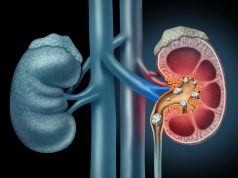Risk for relapse lower with removal of small, asymptomatic, secondary stones during endoscopic removal of primary stone
THURSDAY, Aug. 11, 2022 (HealthDay News) — Removing small, asymptomatic stones during endoscopic removal of ureteral or contralateral kidney stones is beneficial, according to a study published in the Aug. 11 issue of the New England Journal of Medicine.
Mathew D. Sorensen, M.D., from the University of Washington School of Medicine in Seattle, and colleagues conducted a randomized trial in which remaining small, asymptomatic stones were removed in 38 patients and not removed in 35 patients during the endoscopic removal of ureteral or contralateral kidney stones.
The researchers found that the treatment group had a longer time to relapse than the control group after a mean follow-up of 4.2 years. Compared with the control group, the restricted mean time to relapse was 75 percent longer in the treatment group (1,631.6 versus 934.2 days). Compared with the control group, the treatment group had a lower risk for relapse (hazard ratio, 0.18), with 16 and 63 percent of patients in the treatment and control groups, respectively, having a relapse. A median of 25.6 minutes was added to the surgery time with treatment. Within two weeks after surgery, five and four patients in the treatment and control groups, respectively, had an emergency department visit.
“Removing small, asymptomatic renal stones during surgery for a ureteral or contralateral stone resulted in fewer subsequent emergency department visits and surgeries and less stone growth than leaving the secondary stones in place,” the authors write.
Editorial (subscription or payment may be required)
Copyright © 2022 HealthDay. All rights reserved.








